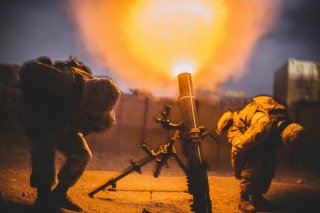The U.S. Marine Corp Wants Kamikaze Bombs To Battle China in a War
The U.S. Marine Corps (USMC) is preparing for a war in the Pacific against a near-peer adversary--that means China. One of their go-to weapons in the future could be a new type of long-range loitering munition or what could be described as a sort of kamikaze bomb.
The U.S. Marine Corps (USMC) is preparing for a war in the Pacific against a near-peer adversary--that means China. One of their go-to weapons in the future could be a new type of long-range loitering munition or what could be described as a sort of kamikaze bomb.
Changing Times
In an effort to become more expeditionary and better prepared for combat in a littoral environment, big changes are coming to the United States Marine Corps. At the heart of the USMC’s pivot from land-based counterinsurgency warfare to their traditional maritime expeditionary role is a need to counter an increasingly aggressive and expansionist China by preparing for a war in the Pacific.
To that end, the USMC has undergone a significant amount of change in recent years, moving to divest all their tank battalions, investing in new ship-to-shore connectors, divesting artillery and some mortar battalions, and finally putting a new Amphibious Combat Vehicle into service. They’ve also been experimenting with unmanned, anti-ship missile-toting JLTVs that could sink Chinese warships, as well as formulating a plan for Marines to hunt down enemy submarines.
And, the latest change coming to the United States Marine Corps: long-range loitering munitions.
Organic Precision Fires
The proposed munition, called Organic Precision Fires - Infantry Light (OPF-IL) would essentially replace the cumbersome and troubled 120mm heavy mortar with a light-weight system that has better range and greater accuracy. The USMC defines the OPF as an “individually operated, man-portable, anti-materiel, anti-personnel ground-launched loitering munition system.”
According to the USMC contract opportunity announcement, the OPF-IL system should be completely transportable, and able to be moved into position, set up, and operated by no more than two Marines in full combat gear. Using a government-supplied radio controller, the system should be resistant to jamming.
Though the Corps is keeping both their 60 and 81mm mortar systems, a firepower capability gap exists for ranges that fall between mortar and artillery range. Range should therefore reach out to about 20 kilometers, or nearly 12.5 miles, with a 90-minute loitering endurance and an anti-personnel and anti-material capability. Lastly, the munition should be capable of swarming targets in tandem with other loitering munitions.
Previously, the Marine Corp had sought a similar capability to keep their aging LAV vehicles relevant. In 2017, some USMC LAVs had been equipped with TOW anti-tank missiles, and the Corps hoped that loitering drone-armed LAVs would complement their anti-tank partners with a deep-penetrating 7-100 kilometer range, or up to 62 miles
Long-Range Loitering Munitions: Future of the USMC?
A swarming, loitering class of munitions would be beneficial to the Corps and allow a couple of Marines to cover a large area, perhaps also allowing a few operators to direct enemy movements by herding them into specific areas, or overwhelm enemy defenses.
Caleb Larson is a Defense Writer based in Europe. He holds a Master of Public Policy and covers U.S. and Russian security, European defense issues, and German politics and society.


